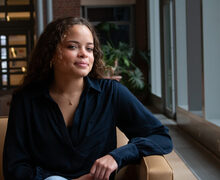Art exhibit commemorates career, artistry of SU professor
Jerome Witkin did not come from a lot of money. Once, when he was 7 years old, he and his mother ventured to The Metropolitan Museum of Art. Witkin ran upstairs to view the gallery. Suddenly, a man with a cane approached him while he was exploring. The man pointed his cane to Witkin’s chest and declared, ‘Dirty little boys like you should not be in museums like this.’
Decades later, Witkin has been featured in more than a dozen of his own solo exhibitions all across the country.
On Sept. 8, Witkin’s most recent solo exhibition, ‘Drawn to Paint,’ will feature his sketches alongside their final paintings. The exhibition, which will show 70 pieces, will open at SUArt Galleries and at XL Projects in downtown Syracuse. Witkin is a professor of painting at the College of Visual and Performing Arts. The exhibition will celebrate Witkin’s life as an artist and 40th anniversary as a professor at Syracuse University.
Witkin was born in Brooklyn, N.Y. During his teenage years, he attended The High School of Music and Art in New York. Afterward, he attended The Cooper Union for the Advancement of Science and Art, where he studied under modernist painter Victor Candell.
Witkin said Candell opened up his eyes to the purpose of art: to go into something that no one would dare explore.
‘There is a surety to the marks he makes on the paper,’ said Francis Sills, a painting major who graduated from SU in 1996. ‘He has such a keen eye and confident hand, something an artist just doesn’t have when they are still in school.’
With one glance, Witkin can accurately paint the position of objects in space or the subtle contours of an edge, Sills said. There is a very thoughtful confidence in his artistry.
His work over this 40-year span is extraordinarily astonishing in the daring nature of his depictions of the human body, said Edward Aiken, associate professor and program coordinator of VPA’s graduate program in museum studies in the Department of Design. Full of ambition, Witkin is constantly pushing the edge in his subject matter.
‘He dares himself to be better and better and better,’ Aiken said.
In the classroom, Witkin always encourages his students to investigate the world through their eyes and hands, Sills said. Witkin places a strong emphasis on not only seeing things, but also studying and recording them.
‘He showed me that it is possible to figure yourself out, and the world, through art,’ Sills said.
Witkin’s goal for his students is for them to create work for themselves and who they are, said illustration major David Kassan, a 1999 SU graduate. Witkin did not want his students to let their art be compromised by others; for instance, becoming an artist who just paints for money.
‘He once told me to die with my hands clean,’ Kassan said.
Witkin’s teaching method is based upon problem solving and pushing his students to think through a painting, said Kassan. He teaches his students to identify with their art and that this will keep them honest and pure to themselves.
‘Art is shock and sensation. My work is the moral imagination —people with imaginations have feeling for others. I cannot erase what there is and what we’ve all experienced,’ Witkin said. ‘Human action is who you become. We are put here not just to look at one another, but to raise each other —and the moral reason is how you improve the lives of others.’
Published on September 6, 2011 at 12:00 pm




